Java中的Lock详解
一、简介
java.util.concurrent.locks.Lock 是一个类似于synchronized 块的线程同步机制。但是 Lock比 synchronized 块更加灵活。Lock是个接口,有个实现类是ReentrantLock。
二、Lock和syncronized的区别
synchronized是Java语言的关键字。Lock是一个接口。
synchronized不需要用户去手动释放锁,发生异常或者线程结束时自动释放锁;Lock则必须要用户去手动释放锁,如果没有主动释放锁,就有可能导致出现死锁现象。
lock可以配置公平策略,实现线程按照先后顺序获取锁。
提供了trylock方法 可以试图获取锁,获取到或获取不到时,返回不同的返回值 让程序可以灵活处理。
lock()和unlock()可以在不同的方法中执行,可以实现同一个线程在上一个方法中lock()在后续的其他方法中unlock(),比syncronized灵活的多。
三、Lock接口抽象方法
void lock():获取锁,如果锁不可用,则出于线程调度的目的,当前线程将被禁用,并且在获取锁之前处于休眠状态。
Lock lock = ...;
lock.lock();
try{
//处理任务
}catch(Exception ex){
}finally{
lock.unlock(); //释放锁
}
boolean tryLock():如果锁可用立即返回true,如果锁不可用立即返回false;
boolean tryLock(long time, TimeUnit unit) throws InterruptedException:如果锁可用,则此方法立即返回true。 如果该锁不可用,则当前线程将出于线程调度目的而被禁用并处于休眠状态,直到发生以下三种情况之一为止:①当前线程获取到该锁;②当前线程被其他线程中断,并且支持中断获取锁;③经过指定的等待时间如果获得了锁,则返回true,没获取到锁返回false。
Lock lock = ...;
if(lock.tryLock()) {
try{
//处理任务
}catch(Exception ex){
}finally{
lock.unlock(); //释放锁
}
}else {
//如果不能获取锁,则直接做其他事情
}
void unlock():释放锁。释放锁的操作放在finally块中进行,以保证锁一定被被释放,防止死锁的发生。
四、ReentrantLock
重入锁也叫做递归锁,指的是同一线程 外层函数获得锁之后 ,内层递归函数仍然有获取该锁的代码,但不受影响。避免死锁问题的,synchronized也可重入。
4.1、synchronized重入测试
public class ReentrantDemo {
public synchronized void method1() {
System.out.println("synchronized method1");
method2();
}
public synchronized void method2() {
System.out.println("synchronized method2");
}
public static void main(String[] args) {
ReentrantDemo reentrantDemo = new ReentrantDemo();
reentrantDemo.method1();
}
}
执行结果

4.2、ReentrantLock重入测试
public class ReentrantDemo implements Runnable {
Lock lock = new ReentrantLock();
@Override
public void run() {
set();
}
public void set() {
try {
lock.lock();
System.out.println("set 方法");
get();
} catch (Exception e) {
e.printStackTrace();
} finally {
lock.unlock();// 必须在finally中释放
}
}
public void get() {
try {
lock.lock();
System.out.println("get 方法");
} catch (Exception e) {
e.printStackTrace();
} finally {
lock.unlock();
}
}
public static void main(String[] args) {
ReentrantDemo reentrantDemo = new ReentrantDemo();
new Thread(reentrantDemo).start();
}
}
测试结果:同一个线程,首先在set方法中获取锁,然后调用get方法,get方法中重复获取同一个锁。两个方法都执行成功。

五、ReentrantReadWriteLock(读写锁)
读写锁,可以分别获取读锁或写锁。也就是说将数据的读写操作分开,分成2个锁来分配给线程,从而使得多个线程可以同时进行读操作。读锁使用共享模式;写锁使用独占模式;读锁可以在没有写锁的时候被多个线程同时持有,写锁是独占的。当有读锁时,写锁就不能获得;而当有写锁时,除了获得写锁的这个线程可以获得读锁外,其他线程不能获得读锁
writeLock():获取写锁。
readLock():获取读锁。
执行三个线程进行读写操作,并设置一个屏障,线程依次准备就绪后未获取锁之前都在等待,当第三个线程执行 cyclicBarrier.await();后屏障解除,三个线程同时执行。
public class WriteAndReadLockTest {
private static ReentrantReadWriteLock reentrantReadWriteLock = new ReentrantReadWriteLock();
private static ThreadPoolExecutor threadPoolExecutor = new ThreadPoolExecutor(10, 10,
60L, TimeUnit.SECONDS, new LinkedBlockingQueue<Runnable>());
private static CyclicBarrier cyclicBarrier = new CyclicBarrier(3);
private static int i = 100;
public static void main(String[] args) {
threadPoolExecutor.execute(()->{
read(Thread.currentThread());
});
threadPoolExecutor.execute(()->{
write(Thread.currentThread());
});
threadPoolExecutor.execute(()->{
read(Thread.currentThread());
});
threadPoolExecutor.shutdown();
}
private static void read(Thread thread) {
try {
cyclicBarrier.await();
} catch (InterruptedException e) {
e.printStackTrace();
} catch (BrokenBarrierException e) {
e.printStackTrace();
}
reentrantReadWriteLock.readLock().lock();
try {
System.out.println("读线程 "+ thread.getName() + " 开始执行, i=" + i);
Thread.sleep(1000);
System.out.println(thread.getName() +" is over!");
} catch (InterruptedException e) {
e.printStackTrace();
} finally {
reentrantReadWriteLock.readLock().unlock();
}
}
private static void write(Thread thread) {
try {
cyclicBarrier.await();
} catch (InterruptedException e) {
e.printStackTrace();
} catch (BrokenBarrierException e) {
e.printStackTrace();
}
reentrantReadWriteLock.writeLock().lock();
try {
i++;
System.out.println("写线程 "+ thread.getName() + " is doing, i=" + i);
System.out.println(thread.getName() +" is over!");
} finally {
reentrantReadWriteLock.writeLock().unlock();
}
}
}
执行结果:线程1先获取到了读锁,因为读锁时可以共享的,所有线程3也可以获取到读锁,线程1、3读操作完成后将读锁释放后,线程2才能获取到写锁并开始执行写操作。

六、公平锁与非公平锁
公平锁:就是很公平,在并发环境中,每个线程在获取锁时会先查看此锁维护的等待队列,如果为空,或者当前线程线程是等待队列的第一个,就占有锁,否则就会加入到等待队列中,以后会按照FIFO的规则从队列中取到自己
非公平锁:比较粗鲁,上来就直接尝试占有锁,如果尝试失败,就再采用类似公平锁那种方式
6.1、如何实现
ReentrantLock:模式是非公平锁。也可通过构造方法创建公平锁;
public ReentrantLock() {
sync = new NonfairSync();
}
public ReentrantLock(boolean fair) {
sync = fair ? new FairSync() : new NonfairSync();
}
ReentrantReadWriteLock:默认是非公平锁,也可以通过构造方法创建公平锁;
public ReentrantReadWriteLock() {
this(false);
}
public ReentrantReadWriteLock(boolean fair) {
sync = fair ? new FairSync() : new NonfairSync();
readerLock = new ReadLock(this);
writerLock = new WriteLock(this);
}
6.2、优缺点
非公平锁性能高于公平锁性能。首先,在恢复一个被挂起的线程与该线程真正运行之间存在着严重的延迟。而且,非公平锁能更充分的利用cpu的时间片,尽量的减少cpu空闲的状态时间。
七、Condition的使用
当满足一定条件时,调用Condition的await()方法使当前线程进入休眠状态进行等待。调用Condition的signalAll()方法唤醒因await()进入休眠的线程。
Lock锁实现同步时需要使用者手动控制锁的获取和释放,其灵活性使得可以实现更复杂的多线程同步和更高的性能,但同时,使用者一定要在获取锁后及时捕获代码运行过程中的异常并在finally代码块中释放锁。
使用Lock锁及其同步条件来实现一个生产者-消费者模型:
public class MessageStorageByLock {
private int maxSize;
private List<String> messages;
private final ReentrantLock lock;
private final Condition conditionWrite;//声明两个锁条件
private final Condition conditionRead;
public MessageStorageByLock(int maxSize) {
this.maxSize = maxSize;
messages = new LinkedList<String>();
lock = new ReentrantLock(true);//true修改锁的公平性,为true时,使用lifo队列来顺序获得锁
conditionWrite = lock.newCondition();//调用newCondition()方法,即new ConditionObject();
conditionRead = lock.newCondition();
}
public void set(String message){
//使用锁实现同步,获取所得操作,当锁被其他线程占用时,当前线程将进入休眠
lock.lock();
try{
while(messages.size() == maxSize){
System.out.print("the message buffer is full now,start into wait()\n");
conditionWrite.await();//满足条件时,线程休眠并释放锁。当调用 signalAll()时。线程唤醒并重新获得锁
}
Thread.sleep(100);
messages.add(message);
System.out.print("add message:"+message+" success\n");
conditionRead.signalAll();//唤醒因conditionRead.await()休眠的线程
}catch (InterruptedException e){
e.printStackTrace();
}finally {
lock.unlock();
}
}
public String get(){
String message = null;
lock.lock();
try{
while(messages.size() == 0){
conditionRead.await();
System.out.print("the message buffer is empty now,start into wait()\n");
}
Thread.sleep(100);
message = ((LinkedList<String>)messages).poll();
System.out.print("get message:"+message+" success\n");
conditionWrite.signalAll();
}catch (InterruptedException e){
e.printStackTrace();
}finally {
lock.unlock();
}
return message;
}
}
Modifier and Type Method and Description
void
lock()
获得锁
void lockInterruptibly()
获取锁定,除非当前线程是 interrupted 。
Condition newCondition()
返回一个新Condition绑定到该实例Lock实例。
boolean tryLock()
只有在调用时才可以获得锁。
boolean tryLock(long time, TimeUnit unit)
如果在给定的等待时间内是空闲的,并且当前的线程尚未得到 interrupted,则获取该锁。
void
unlock();
释放锁
package java.util.concurrent.locks;
import java.util.concurrent.TimeUnit;
public interface Lock {
void lock();
void lockInterruptibly() throws InterruptedException;
boolean tryLock();
boolean tryLock(long time, TimeUnit unit) throws InterruptedException;
void unlock();
Condition newCondition();
}
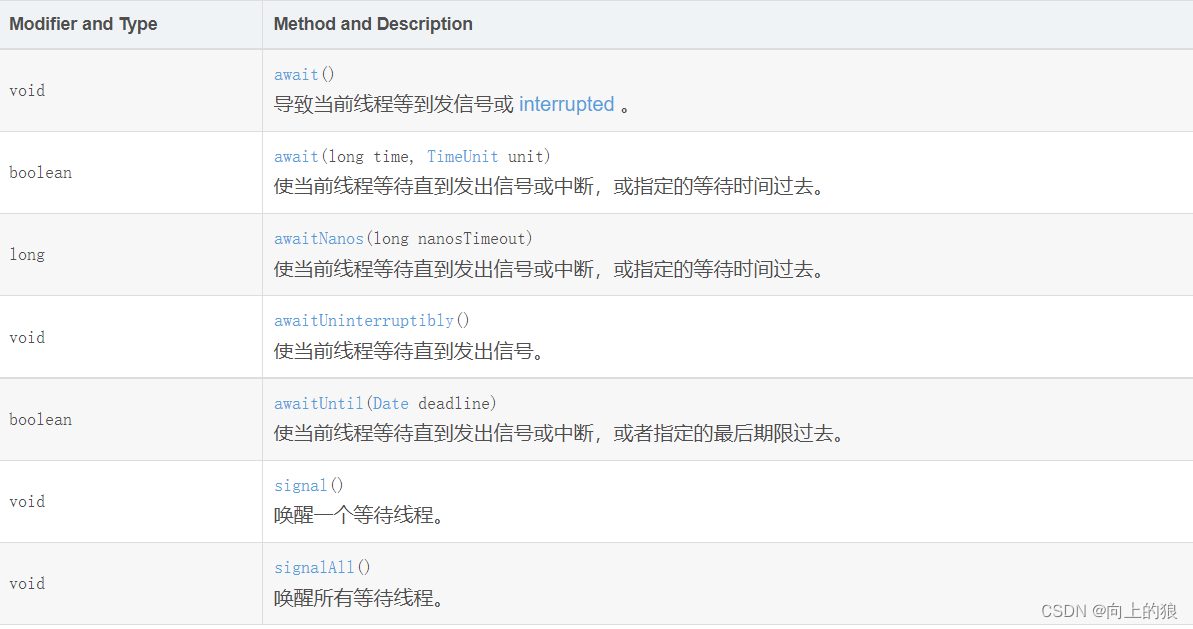
package java.util.concurrent.locks;
import java.util.concurrent.TimeUnit;
import java.util.Date;
public interface Condition {
void await() throws InterruptedException;
void awaitUninterruptibly();
long awaitNanos(long nanosTimeout) throws InterruptedException;
boolean await(long time, TimeUnit unit) throws InterruptedException;
boolean awaitUntil(Date deadline) throws InterruptedException;
void signal();
void signalAll();
}
八、代码举例
8.1、Demo1(先演示一下锁的可重入性)
package com.szh.lock;
/**
* 演示锁的可重入性
*/
public class Test01 {
public synchronized void metthod1() {
System.out.println("同步方法1");
//线程执行 metthod1() 方法,默认 this 作为锁对象,
//在 metthod1() 方法中调用了 method2() 方法,注意当前线程还是持有 this 锁对象的
//method2() 同步方法默认的锁对象也是 this 对象, 要执行 method2() 必须先获得 this 锁对象,
//当前 this 对象被当前线程持有,可以 再次获得 this 对象, 这就是锁的可重入性.
//假设锁不可重入的话,可能会造成死锁
method2();
}
public synchronized void method2() {
System.out.println("同步方法2");
method3();
}
public synchronized void method3() {
System.out.println("同步方法3");
}
public static void main(String[] args) {
Test01 obj=new Test01();
new Thread(new Runnable() {
@Override
public void run() {
obj.metthod1();
}
}).start();
}
}
运行结果
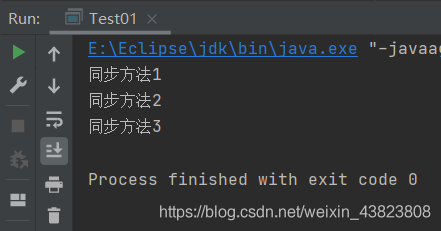
8.2、Demo2(ReentrantLock的基本使用)
package com.szh.lock;
import java.util.concurrent.locks.Lock;
import java.util.concurrent.locks.ReentrantLock;
/*** ReentrantLock 的基本使用
*/
public class Test02 {
//定义一个显示锁
static Lock lock=new ReentrantLock();
public static void method() {
//先获得锁
lock.lock();
//for循环此时就是同步代码块
for (int i = 0; i < 3; i++) {
System.out.println(Thread.currentThread().getName() + " ---> " + i);
}
//释放锁
lock.unlock();
}
public static void main(String[] args) {
Runnable r=new Runnable() {
@Override
public void run() {
method();
}
};
//启动三个线程
new Thread(r).start();
new Thread(r).start();
new Thread(r).start();
}
}
运行结果

8.3、Demo3(使用Lock锁同步不同方法中的代码块)
package com.szh.lock;
import java.util.concurrent.locks.Lock;
import java.util.concurrent.locks.ReentrantLock;
/**
* 使用 Lock 锁同步不同方法中的同步代码块
*/
public class Test03 {
//定义锁对象
static Lock lock=new ReentrantLock();
public static void method1() {
//经常在 try 代码块中获得 Lock 锁, 在 finally 子句中释放锁
try {
lock.lock(); //获得锁
System.out.println(Thread.currentThread().getName() + " ---method1--- " + System.currentTimeMillis());
Thread.sleep(1000);
System.out.println(Thread.currentThread().getName() + " ---method1--- " + System.currentTimeMillis());
} catch (InterruptedException e) {
e.printStackTrace();
}finally {
lock.unlock(); //释放锁
}
}
public static void method2() {
//经常在 try 代码块中获得 Lock 锁, 在 finally 子句中释放锁
try {
lock.lock(); //获得锁
System.out.println(Thread.currentThread().getName() + " ---method2--- " + System.currentTimeMillis());
Thread.sleep(1000);
System.out.println(Thread.currentThread().getName() + " ---method2--- " + System.currentTimeMillis());
} catch (InterruptedException e) {
e.printStackTrace();
}finally {
lock.unlock(); //释放锁
}
}
public static void main(String[] args) {
Runnable r1=new Runnable() {
@Override
public void run() {
method1();
}
};
Runnable r2=new Runnable() {
@Override
public void run() {
method2();
}
};
new Thread(r1).start();
new Thread(r1).start();
new Thread(r2).start();
new Thread(r2).start();
}
}
运行结果

8.4、Demo4(ReentrantLock锁的可重入性)
package com.szh.lock;
import java.util.concurrent.locks.Lock;
import java.util.concurrent.locks.ReentrantLock;
/**
* ReentrantLock 锁的可重入性
*/
public class Test04 {
static class SubThread extends Thread {
//定义锁对象
private static Lock lock=new ReentrantLock();
//定义变量
private static int num=0;
@Override
public void run() {
for (int i = 0; i < 10000; i++) {
try {
//可重入锁指可以反复获得该锁
lock.lock();
lock.lock();
num++;
}finally {
lock.unlock();
lock.unlock();
}
}
}
}
public static void main(String[] args) throws InterruptedException {
SubThread t1=new SubThread();
SubThread t2=new SubThread();
t1.start();
t2.start();
t1.join();
t2.join();
System.out.println(SubThread.num);
}
}
运行结果
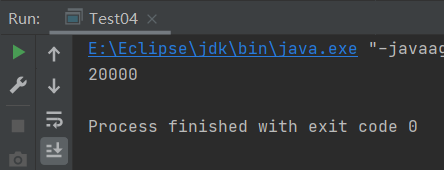
8.5、Demo5(ReentrantLock的lockInterruptibly()方法)
package com.szh.lock;
import java.util.concurrent.locks.Lock;
import java.util.concurrent.locks.ReentrantLock;
/**
* lockInterruptibly()方法
* 如果当前线程未被中断则获得锁,
* 如果当前线程被中断则出现异常.
*/
public class Test05 {
static class Service {
private Lock lock=new ReentrantLock(); //定义锁对象
public void serviceMethod() {
try {
//lock.lock(); 获得锁, 即使调用了线程的 interrupt() 方法, 也没有真正的中断线程
//如果线程被中断了, 不会获得锁, 会产生异常
lock.lockInterruptibly();
System.out.println(Thread.currentThread().getName() + " --- begin lock");
//执行一段耗时的操作
for (int i = 0; i < Integer.MAX_VALUE; i++) {
new StringBuilder();
}
System.out.println(Thread.currentThread().getName() + " --- end lock");
} catch (InterruptedException e) {
e.printStackTrace();
} finally {
System.out.println(Thread.currentThread().getName() + " === 释放锁");
lock.unlock(); //释放锁
}
}
}
public static void main(String[] args) throws InterruptedException {
Service s=new Service();
Runnable r=new Runnable() {
@Override
public void run() {
s.serviceMethod();
}
};
Thread t1=new Thread(r);
t1.start();
Thread.sleep(50);
Thread t2=new Thread(r);
t2.start();
Thread.sleep(50);
t2.interrupt(); //中断 t2 线程
}
}
运行结果
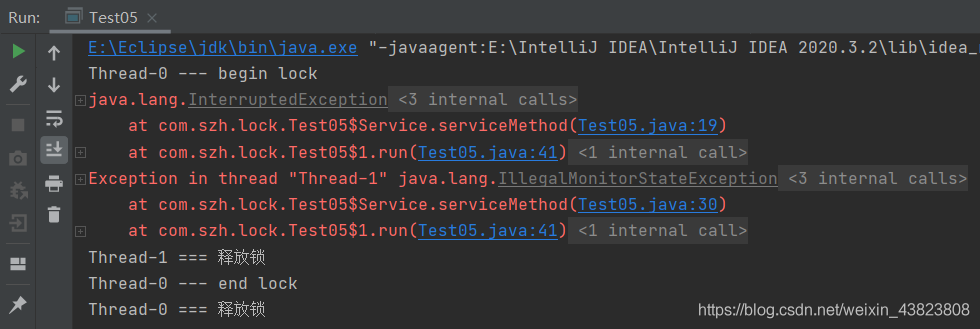
8.6、Demo6(lockInterruptibly()方法可以避免死锁)
package com.szh.lock;
import java.util.concurrent.locks.ReentrantLock;
/**
* 通过 ReentrantLock 锁的 lockInterruptibly() 方法避免死锁的产生
*/
public class Test06 {
static class MyLock implements Runnable {
//创建两个ReentrantLock等锁对象
private static ReentrantLock lock1=new ReentrantLock();
private static ReentrantLock lock2=new ReentrantLock();
int lockNum; //定义整数变量,决定使用哪个锁,偶数用lock1,奇数用lock2
public MyLock(int lockNum) {
this.lockNum=lockNum;
}
@Override
public void run() {
try {
if (lockNum % 2 == 1) { //奇数, 先锁 1, 再锁 2
lock1.lockInterruptibly();
System.out.println(Thread.currentThread().getName() + "获得锁1,还需要获得锁2");
Thread.sleep(1000);
lock2.lockInterruptibly();
System.out.println(Thread.currentThread().getName() + "同时获得了锁1与锁2");
}else { //偶数, 先锁 2, 再锁 1
lock2.lockInterruptibly();
System.out.println(Thread.currentThread().getName() + "获得了锁2,还需要获得锁1");
Thread.sleep(1000);
lock1.lockInterruptibly();
System.out.println(Thread.currentThread().getName() + "同时获得了锁1与锁2");
}
}catch (InterruptedException e) {
e.printStackTrace();
}finally {
if (lock1.isHeldByCurrentThread()) { //判断当前线程是否持有该锁
lock1.unlock();
}
if (lock2.isHeldByCurrentThread()) {
lock2.unlock();
}
System.out.println(Thread.currentThread().getName() + "线程退出");
}
}
}
public static void main(String[] args) throws InterruptedException {
MyLock myLock1=new MyLock(11);
MyLock myLock2=new MyLock(22);
Thread t1=new Thread(myLock1);
Thread t2=new Thread(myLock2);
t1.start();
t2.start();
//在 main 线程, 等待 3000 ms, 如果还有线程没有结束就中断该线程
Thread.sleep(1000 * 3);
//可以中断任何一个线程来解决死锁, t2 线程会放弃对锁 1 的申请, 同时释放锁 2, t1 线程会完成它的任务
if (t2.isAlive()) {
t2.interrupt();
}
}
}
运行结果

8.7、Demo7(ReentrantLock的tryLock(long time, TimeUnit unit)方法)
package com.szh.lock;
import java.util.concurrent.TimeUnit;
import java.util.concurrent.locks.ReentrantLock;
/**
* tryLock(long time, TimeUnit unit) 的作用在给定等待时长内,
* 锁没有被另外的线程持有, 并且当前线程也没有被中断, 则获得该锁.
* 通过该方法可以实现锁对象的限时等待.
*/
public class Test07 {
static class TimeLock implements Runnable {
private static ReentrantLock lock=new ReentrantLock(); //定义锁对象
@Override
public void run() {
try {
//假设 t1 线程先持有锁, 完成任务需要 4 秒钟,
//这个时候 t2 线程尝试获得锁, t2 线程在 3 秒内还没有获得锁的话, 那么它就不再等了,直接放弃
if (lock.tryLock(3, TimeUnit.SECONDS)) {
System.out.println(Thread.currentThread().getName() + "获得锁,执行耗时任务");
Thread.sleep(1000 * 4);
/*
假设 t1 线程先持有锁, 完成任务需要 2 秒钟
这个时候t2 线程尝试获得锁, t2 线程会一直尝试
在它约定尝试的 3 秒内可以获得锁对象
*/
//Thread.sleep(1000 * 2);
}else {
System.out.println(Thread.currentThread().getName() + "没有获得锁");
}
} catch (InterruptedException e) {
e.printStackTrace();
} finally {
if (lock.isHeldByCurrentThread()) {
lock.unlock();
}
}
}
}
public static void main(String[] args) {
TimeLock timeLock=new TimeLock();
Thread t1=new Thread(timeLock);
Thread t2=new Thread(timeLock);
t1.setName("t1");
t2.setName("t2");
t1.start();
t2.start();
}
}
运行结果
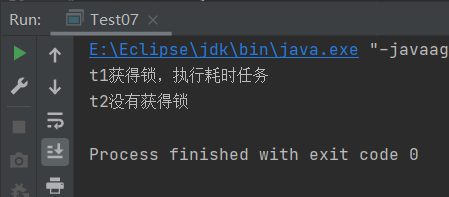
8.8、Demo8(ReentrantLock的tryLock()方法)
package com.szh.lock;
import java.util.concurrent.locks.ReentrantLock;
/**
* tryLock() 当锁对象没有被其他线程持有的情况下, 才会获得该锁定
*/
public class Test08 {
static class Service {
private ReentrantLock lock=new ReentrantLock();
public void serviceMethod() {
try {
if (lock.tryLock()) {
System.out.println(Thread.currentThread().getName() + "获得锁定");
Thread.sleep(1000 * 3); //模拟执行任务的时长
}else {
System.out.println(Thread.currentThread().getName() + "没有获得锁定");
}
}catch (InterruptedException e) {
e.printStackTrace();
}finally {
if (lock.isHeldByCurrentThread()) {
lock.unlock();
}
}
}
}
public static void main(String[] args) throws InterruptedException {
Service service=new Service();
Runnable r=new Runnable() {
@Override
public void run() {
service.serviceMethod();
}
};
Thread t1=new Thread(r);
t1.start();
Thread.sleep(100);
Thread t2=new Thread(r);
t2.start();
}
}
运行结果

8.9、Demo9(tryLock()方法可以避免死锁)
package com.szh.lock;
import java.util.concurrent.locks.ReentrantLock;
/**
* 使用 tryLock() 可以避免死锁
*/
public class Test09 {
static class MyLock implements Runnable {
private static ReentrantLock lock1=new ReentrantLock();
private static ReentrantLock lock2=new ReentrantLock();
private int lockNum;
public MyLock(int lockNum) {
this.lockNum=lockNum;
}
@Override
public void run() {
if (lockNum % 2 == 0) { //偶数先锁 1, 再锁 2
while (true) {
try {
if (lock1.tryLock()) {
System.out.println(Thread.currentThread().getName() + "获得了锁1,还想获得锁2");
Thread.sleep(50);
try {
if (lock2.tryLock()) {
System.out.println(Thread.currentThread().getName() + "同时获得了锁1与锁2,完成任务了");
return;
}
} finally {
if (lock2.isHeldByCurrentThread()) {
lock2.unlock();
}
}
}
} catch (InterruptedException e) {
e.printStackTrace();
} finally {
if (lock1.isHeldByCurrentThread()) {
lock1.unlock();
}
}
}
}else { //奇数就先锁 2, 再锁 1
while (true) {
try {
if (lock2.tryLock()) {
System.out.println(Thread.currentThread().getName() + "获得了锁2,还想获得锁1");
Thread.sleep(50);
try {
if (lock1.tryLock()) {
System.out.println(Thread.currentThread().getName() + "同时获得了锁1与锁2,完成任务了");
return;
}
} finally {
if (lock1.isHeldByCurrentThread()) {
lock1.unlock();
}
}
}
} catch (InterruptedException e) {
e.printStackTrace();
} finally {
if (lock2.isHeldByCurrentThread()) {
lock2.unlock();
}
}
}
}
}
}
public static void main(String[] args) {
MyLock lock1=new MyLock(11);
MyLock lock2=new MyLock(22);
Thread t1=new Thread(lock1);
Thread t2=new Thread(lock2);
t1.start();
t2.start();
//运行后, 使用 tryLock() 尝试获得锁, 不会傻傻的等待, 通过循环不停的再次尝试, 如果等待的时间足够长, 线程总是会获得想要的资源
}
}
运行结果
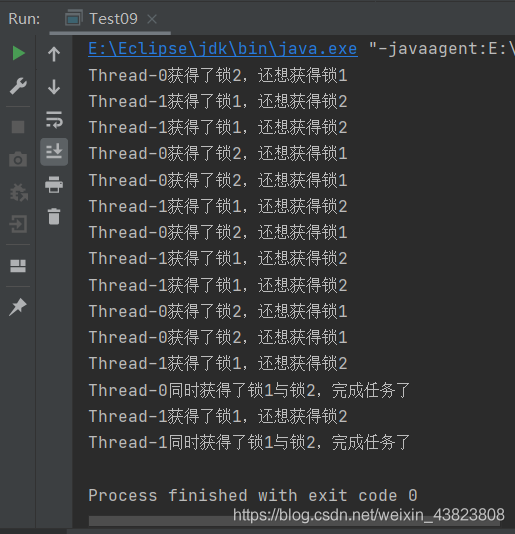
————————————————
版权声明:本文为CSDN博主「向上的狼」的原创文章,遵循CC 4.0 BY-SA版权协议,转载请附上原文出处链接及本声明。
原文链接:https://blog.csdn.net/m0_50370837/article/details/124471888